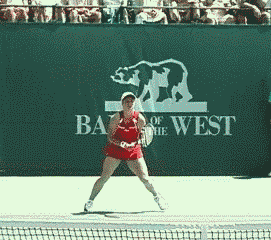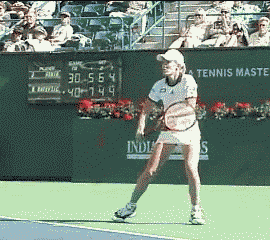| TennisOne Lessons Women’s Tennis: A Historical Perspective David W. Smith, Senior Editor TennisOne When reviewing the historical perspective of tennis and how it has changed over time, we must not dismiss the women’s game. Perhaps even more apparent than the changes in the men’s game, the women’s game has evolved tremendously over the last three decades.
Some consider Billie Jean King the "mother of modern tennis." In my opinion, it was her more aggressive style of play that ushered in what could be considered the modern game for women. It isn’t that she was an all-court player who could serve and volley better than anyone else; the majority of women in her day played a serve and volley style game and many were good at it. in my opinion, it was more her aggressive footwork and mindset that paved the way for players like Martina Navratilova, Gabriella Sabatini, and Monica Seles. And it influenced even the aggressive baseline players to come, who played a far different game than what Chris Evert, Tracy Austin, and Evonne Gooligong played years earlier. There is an image of these players—playing the the baseline game —with long, fluid strokes that were pretty to watch, but lacked the penetrating pace and forcing play that King and Navratilova demonstrated in their eras and which would eventually evolve further into the attacking baseline game played today. It would seem that there was a transition time between King and the more aggressive players that came after Evert and Austin. And, it would make sense that young players and coaches who wanted to emulate King’s aggressive style would take time to emerge and master the game at the pro level. Evert’s ‘ice-queen’ mentality and pinpoint accuracy dethroned King as she moved past her prime. But, the stage was set and King established a strong, aggressive style that many young girls were beginning to emulate. Similar to the question of how well a Laver, Hoad, Rosewall, or Gonzales would do against today’s top men, we could ask, “Would a Virginia Wade, Margaret Court, or even King be able to compete equally with Justine Henin-Hardenne, the Williams sisters, Maria Sharapova, Kim Clijsters or Amelie Mauresmo? Would they even be able to compete against today’s lower-ranked women?
Certainly, the ageless Navratilova has shown she was able to compete in today’s era (of doubles) but, as mentioned earlier, she was one who followed King with a game that was far more athletic and aggressive than we saw in previous generations. Like Ivan Lendl on the men’s tour, King and later Navratilova, brought a physical element to the women’s tour, with strength training and conditioning that was not even considered in previous eras. However, we can take a look at film and compare the shots, strategies, and skills used in a particular era and see how they would stack up against other players from another era. Shots and strategies can be somewhat objectively compared. Skills, on the other hand, are a bit more subjective in their determination. I personally believe that, like the men, the champion women of yesteryear, given the training, equipment, and perception of power of today, would be as competitive today as they were in their own era. But if we compare the style of play that was predominantly used in previous eras and stack that style up against today’s power, speed, placement, and footwork, I think most people would agree that today’s game is far more advanced than the way tennis was played just a few decades ago.
I sat next to Justine Henin-Hardenne at the U.S. Open a few years ago in the Players Lounge and can tell you that she certainly is no bigger than Tracy Austin was in her prime. Yet, i've seen Justine clock up to 110 mph and more on her serve. Let me tell you, she is one excellent conditioned woman! One could argue that the racquet technology has contributed greatly to the difference in service speed. And, while this is certainly a major contributor to the power of today’s game in general, it would only be part of the bigger picture. Few players in Austin’s or King’s era were as physically conditioned or trained as today’s players are. Today, even a player such as Bethanie Mattek, a 115th ranked 21 year-old on the WTA tour, serves over 120 mph. Coached by a good friend of mine and terrific pro, Scott Adams, Mattek who stands at only 5’6”, can serve at nearly twice the speed Austin served in her prime! Racquet technology alone can not account for that. The depth of women’s tennis is far deeper than it was thirty years ago. This is probably truer in the service department. 298th ranked Brenda Schultz-McCarthy has one of the fastest serves on tour at 123 mph (served at this year’s Wimbledon). She broke the 120 mph barrier in 1990 when she reached a career best 4th round at Wimbledon. Obviously, the serve is not the sole criteria for success! However, compared to the service speeds of King’s era and before, we can safely say that this part of the game has changed dramatically!
Groundstroke Pace However, even with Billie Jean King’s aggressive power, you seldom saw the kind of winners we see from heavy hitting pro women on the baseline today. While some claim the speed of today’s game is equipment-driven, I have to agree only to a point. The swing speed of top players has changed dramatically. The perception of potential speed has changed and evolved. Just like someone breaking a world-record of any kind, that record is destined to be broken again. And in tennis, developing the kind of swing speed used consistently has occurred, not necessarily due to racquet design, but due to training and stroke development among pros. Each generation of players learns and builds upon the players who came before them. Their eyes open up to what is possible. I have my 8 year-old daughter hitting with a lot of racquet head speed, far more than I did when I was first introduced to the game. Why? Because I didn’t hit with the kind of topspin my daughter has been introduced to. Back then we hit flatter, continental grip forehands and backhands, a lot of slice, and we kept balls lower than players do now.
In King’s day, the women, like the men, came into the net consistently. The slice was a common shot-of-choice for returns, especially on the backhand side. While Fabrice Santoro has shown that the slice can still be used as a stroke choice, few players have utilized the slice as it was used thirty years ago. The slice was used as an approach, a return, a lob, and a volley. No wonder so many pros in that era used the continental grip almost exclusively! And not so long ago, Steffi Graff hit almost exclusively slice backhands while dominating women’s tennis for years. Of course, it was her potent and powerful forehand that was feared. In terms of evolution of the game, the grip on both the topspin forehand and backhand has helped mold the tennis into what we see today. Many pros use full western forehand grips and many more use semi-westerns. I would have to say that McEnroe was the last man to use a continental grip almost exclusively. WTA tour players now use a strong eastern backhand grip on their one-handed topspin backhands along with the semi or full western grip on their forehands. Both grips promote big topspin swings and result in better ball rotation.
As I have said in other articles, I find this interesting since so many other sports used two-handed swings; namely golf, baseball, hockey, and cricket. Yet it wasn’t until Jimmy Connors and Evert, then a short time later Austin, showed that it was no fluke or exception that two hands could make it not only in the pros, but it could be taken to the top of the men’s and women’s game, that the juniors began following their lead. Today, the one-handed backhand has evolved too, from a conservative slice, and occasionally hit topspin used decades ago, to a powerful, topspin weapon today. The grip is stronger, almost an extreme eastern backhand grip with full angular momentum and racquet speed that imparts not only pace but heavy topspin as needed. It is a lot of fun to evaluate and make suppositions regarding the comparison of the game from a few short decades ago to that of today’s game. It will be even more interesting to see just what we will be saying about today’s players thirty years from now! Your comments are welcome. Let us know what you think about Dave Smith's article by emailing us here at TennisOne .
TENNIS MASTERYFinally. a resource that unlocks these mysteries: • Why do m • Why are making changes in one's game so frustratingly difficult? • What tennis teaching methods are disruptive or detrimental to player progression? Read David W. Smith's TENNIS MASTERY and learn not just how to avoid playing at mediocre levels, but how the best players in the world Master the sport of tennis! "With a depth of knowledge and fresh perspective, TENNIS MASTERY is set to become a manual for tennis instructors and a measure for tennis literature." Richard Wigley, Director, Kayenta Tennis Center, Ivins Utah. Take in David Smith's 30 plus years in the tennis teaching industry. This 335-page manual will provide for every level of player as well as support for all tennis-teaching professionals, a blueprint for reaching higher levels of tennis mastery. Order TENNIS MASTERY at tenniswarehouse.com , or go to tennismastery.net for exciting excerpts from the book and a host of tennis information! And check out David Smith's other articles found here at TennisONE.com Learn more from Dave Smith at his Desert Shadows Tennis Institute!
Next available DSTI camps are November 28th - 30th and December 5th - 7th! Space is limited! Call (435) 628-5000 and ask for the tennis pro shop to learn more about Desert Shadows Tennis Institute. Learn the Advanced Foundation, discover tools to master more advanced techniques for all strokes, and discover that staying at the same level you are is NOT AN OPTION! A select number of camps are available but space is very limited. The DSTI camps take place in St. George, Utah, in the heart of ‘Color Country’—the incredible beauty of Southern Utah. Zion, Bryce Canyon and Grand Canyon National Parks are all nearby! Hurry to reserve your spot now for a true ‘tennis destination’ opportunity! “The most informative, intuitive tennis camp I have ever attended.” Randy S. Colorado “Dave and his staff have a passion for the game and a personal care for their students.” S. Loo, Nevada “The depth of instruction is far superior to that of other tennis camps I’ve been.” Tom T. Nevada |



 illions of tennis players stagnate at levels far below their potential?
illions of tennis players stagnate at levels far below their potential?  Join Dave Smith in an intimate, ultimate tennis camp: Desert Shadows Tennis Institute (DSTI) is an intense, 3-day camp that accepts only 12 players to work directly with Dave and his staff of certified and accomplished pros. Over 18 hours of tennis instruction is included along with a copy of Dave’s best-selling tennis book, TENNIS MASTERY, a DVD of instruction, breakfast and lunch each day, and a lifetime of tennis secrets!
Join Dave Smith in an intimate, ultimate tennis camp: Desert Shadows Tennis Institute (DSTI) is an intense, 3-day camp that accepts only 12 players to work directly with Dave and his staff of certified and accomplished pros. Over 18 hours of tennis instruction is included along with a copy of Dave’s best-selling tennis book, TENNIS MASTERY, a DVD of instruction, breakfast and lunch each day, and a lifetime of tennis secrets!